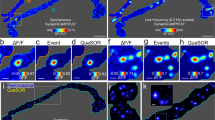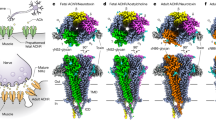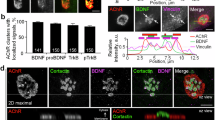Abstract
The reality of axoplasmic transport is widely accepted; various neurotransmitters1–3, enzymes2–4, labelled proteins5 and peptides6 are known to move rapidly along the axons of different nerve fibres. In the terminals of sympathetic nerves, nor adrenaline release is controlled by various regulatory mechanisms which imply the occurrence of presynaptic receptors7. In this regard, there is considerable indirect physiological evidence for the existence of muscarinic cholinergic receptors in the sympathetic nerve endings7–9; the stimulation by acetylcholine of such presynaptic receptors elicits an inhibitory effect on noradrenaline release8,9. We now provide direct biochemical evidence for the occurrence in dog splenic nerve of muscarinic receptors which seem to move along the axon as suggested by their rapid accumulation on either side of a ligature.
This is a preview of subscription content, access via your institution
Access options
Subscribe to this journal
Receive 51 print issues and online access
$199.00 per year
only $3.90 per issue
Buy this article
- Purchase on SpringerLink
- Instant access to full article PDF
Prices may be subject to local taxes which are calculated during checkout
Similar content being viewed by others
References
Dahlström, A. Phil. Trans. R. Soc. B261, 325–358 (1971).
Banks, P. & Mayor, D. Biochem. Soc. Symp. 36, 133–149 (1973).
Laduron, P. in Dynamics of Degeneration and Growth in Neurons (eds Fuxe, K., Olson, L. & Zotterman, Y.) 245–256 (Pergamon, Oxford, 1974).
Lubinska, L. & Niemierko, S. Brain Res. 27, 328–352 (1971).
Ochs, S. J. Physiol., Lond. 277, 627–645 (1972).
Giachetti, A. & Said, S. I. Nature 281, 574–575 (1979).
Langer, S. Z. Biochem. Pharmac. 23, 1793–1800 (1974).
Löffelholz, K. & Muscholl, E. Naunyn-Schmiedehergs Archs exp. path. Pharmak. 265, 1–15 (1969).
Vanhoutte, P. M. Fedn Proc. 36, 2444–2449 (1977).
Laduron, P. & Belpaire, F. Life Sci. 7, 1–7 (1968).
Teichberg, S. & Holtzman, E. J. Cell Biol. 57, 88–108 (1973).
Sharma, V. K. & Banerjee, S. P. Nature 272, 276–278 (1978).
De Potter, W. P. & Chubb, I. W. Biochem. J. 125, 375–376 (1971).
Brimijoin, S. J. Neurochem. 19, 2183–2193 (1972).
Droz, B. J. Microsc. 6, 201–228 (1967).
Goldstein, J. L., Anderson, R. G. W. & Brown, M. S. Nature 279, 679–685 (1979).
Teichberg, S., Holtzman, E., Crain, S. M. & Peterson, E. R. J. Cell Biol. 67, 215–230 (1975).
Schwartz, J. C., Costentin, J., Martres, M. P., Protais, P. & Baudry, M. Neuropharmacology 17, 665–685 (1978).
Laduron, P. M., Verwimp, M. & Leysen, J. E. J. Neurochem. 32, 421–427 (1979).
Gorissen, H., Aerts, G. & Laduron, P. FEBS Lett. 96, 64–68 (1978).
Coyle, J. T. & Henry, D. J. Neurochem. 21, 61–67 (1973).
Author information
Authors and Affiliations
Rights and permissions
About this article
Cite this article
Laduron, P. Axoplasmic transport of muscarinic receptors. Nature 286, 287–288 (1980). https://doi.org/10.1038/286287a0
Received:
Accepted:
Issue date:
DOI: https://doi.org/10.1038/286287a0
This article is cited by
-
Leukocyte mobilization from the guinea pig spleen by muscarinic cholinergic stimulation
Experientia (1994)
-
Transport of receptors
Molecular Neurobiology (1992)
-
Alterations in neocortical expression of nicotinic acetylcholine receptor mRNAs following unilateral lesions of the rat nucleus basalis magnocellularis
Journal of Neural Transmission (1990)



